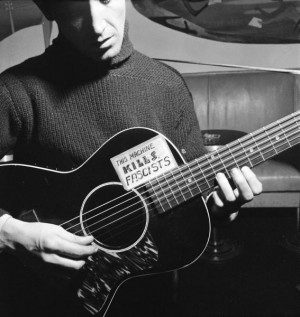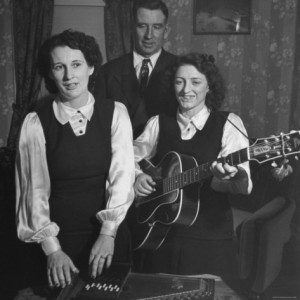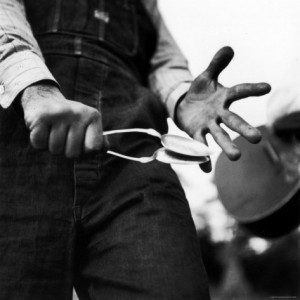
In a lace-curtained living room of a cabin by the Greenbrier River, four men I had just met picked up a banjo, a guitar, a mandolin, and an upright bass and cracked my world open. My hair was wet from the river and a summer breeze was blowing in from the Monogahela mountains, but as they played, hot fire passed through me.
Maybe you’ve been listening. Maybe you’ve noticed. Maybe your world has been cracked open recently too. American country music, coming under names as varied and charged as Americana, folk, alt-country, roots, bluegrass, and old time, has arrived to claim its seat at the dinner table in the elite world of urban artistic and cultural centers.
Or perhaps you’ve always been listening. Perhaps you’re not fooled at all by this new trend towards fancy labels. To you, the music’s always been Country, and always will be.
The journey may vary, but the reality remains, that in the last ten years, the meaning of Country music as a genre has undergone intense and productive transformation, and accordingly, so has its fan base. 95 million Americans are country music fans, reports 2011 data from the Country Music Association, and they may not be the Americans one might expect. One in two people with an income of $100,000-plus are country fans, as are one in three people who have “professional or managerial jobs.” One in four of the people who live in the top five DMA’s (New York City, Los Angeles, Chicago, Philadelphia, Dallas) are country fans. Country music now ranks second, just after Hip Hop, for the music genre with the most “likes” by college student Facebook users. Yet, country music is by and large still associated with a lifestyle that is envisioned as geographically Southern and/or rural, politically conservative, and culturally un-complicated. City dwellers in urban centers as diverse as Brooklyn, West Philadelphia, Austin, Berkeley, Portland, and Burlington have adopted “bluegrass,” “roots,” and “Americana” as terms to call their own—cultivating an image of plaid and cowboy boots, of loving the woods in a largely symbolic way, and swilling whiskey from mason jars much in the tradition of the urban folk revival of the 1960s and 70s—but do not often extend the same sense of connection or hipness to the term “country” music.
What I know is this: ever since my life first touched country music in that cabin in southeastern West Virginia in the summer of 2009, I couldn’t lay it down. I believe in calling what I heard “country” music because language is powerful connection and Bluegrass is inextricably tied, along with Pop Country and Old Time, to the greater history of American traditional and narrative music that is and must be called “country.” Country music spoke to my life. Country music made my life make sense. And yet I felt at once implicated in, and at odds with, country music. As a New York City-born, liberal arts college-educated, Jewish, queer, social justice-minded feminist, I don’t fit any of the stereotypes of the country music audience. The two questions that began to own my mind were: what is it about country music that makes me feel like fire is running through me? And finally, can this music belong to me?
To answer these questions, I traveled more than 10,000 miles around America, for three months, living out of my pick up truck. I saw good country music and I saw it performed live—in old railroad line cafés in Kansas, bars in Nashville and Asheville, rodeos in Wyoming, jams in California, country music clubs in Austin. And I listened to it on the radio—country music was the only kind of music that I could always find on the radio, even when there was not a town around in forty miles, even in Seattle or Birmingham or San Francisco.
But I returned, and though I’d learned a lot and listened a lot and felt on fire a lot, I still had no answers. So I turned, as Joan Didion would say, “to the literature.”
Long regarded as the authoritative text on the history and major trends of American country music, Bill C. Malone’s Country Music USA was recently revised and updated for a third edition, which features a new preface by the author as well as an entirely new chapter on country music from 2002-2010 written by one of the most exciting contemporary scholars of Country music, Jocelyn R. Neal, Professor of Music at the University of North Carolina in Chapel Hill. The book is a comprehensive look at the genre’s roots and evolution, covering everything from Bluegrass to Bob Dylan to Taylor Swift.
In the preface to this new third edition, Malone offers the explanation that much of country music’s appeal, both during the urban folk revival of the Bob Dylan era and now, is due to the ways in which the music references a “search for simpler lifestyles in the United States, and a healthy recognition that people can make their own music.” He also claims that country capitalizes on these themes on purpose in order to “exploit urban America’s romantic affection for its rural past.” Professor Jocelyn Neal cites specific reasons for why country music has enjoyed such a comeback in popularity in post 911 America, saying “a noticeable return to traditional sounds and roots music followed, sparked in part by the O Brother, Where Art Thou? soundtrack and fueled by domestic and global events, including ongoing U.S. military deployments.”  Echoing Malone’s claims that country music became tied up with the radical politics of the Back to the Land movements of the 1970s, Neal emphasizes the ways in which current American traditional music has come to be a cultural signifier of a certain rebellious, anti-capitalist value system. Writes Neal, “Nashville’s Old Crow Medicine Show [has] developed a cult-like following among young audiences who find their old-time string-band sounds as socially rebellious as punk was three decades earlier, and as cowpunk was in the nineties.”
Echoing Malone’s claims that country music became tied up with the radical politics of the Back to the Land movements of the 1970s, Neal emphasizes the ways in which current American traditional music has come to be a cultural signifier of a certain rebellious, anti-capitalist value system. Writes Neal, “Nashville’s Old Crow Medicine Show [has] developed a cult-like following among young audiences who find their old-time string-band sounds as socially rebellious as punk was three decades earlier, and as cowpunk was in the nineties.”
Finally, Neal addresses questions of naming and language head on: “Avoidance of the term ‘country’ is becoming increasingly common, even by musicians whose influences and musical style are unquestionably rooted in the genre…Instead, young singers seeking credibility especially among college-age audiences increasingly turn to terms such as ‘roots’ and ‘bluegrass’ to show lineage and stylistic affinity…voluntary affiliation with the genre [country] is on the wane.”
So I went back to my notes and journals and memories of listening to country music for three months on the radio. It finally dawned on me that at the same time as country music is traditional in its values (patriotism, family, heterosexual love, pick up trucks), it also offers a vision of American people that is profoundly complicated and even transgressive: people that are concerned with politics, troubled by capitalism, aware of power structures, and challenging traditional ideals of masculinity and femininity.
I thought about James Wesley’s “Real,” for example. The song goes:
Where I live, housewives don’t act like that/ And the survivors are farmers in John Deere hats/ Our Amazing race is beating the check /Praying that the bank ain’t ran it through yet… It’s the damn old weevils and the market and the weeds…Real, like a job you lose ‘cause it moves to Mexico…
Here we see Wesley bringing awareness to the fact that the agricultural way of life is under siege, widespread rural financial hardship, and concern over job outsourcing, in a way that reflects a profound awareness of power structures at work and inequality, at the same time as it reinforces a love and a pride for a down home way of life. Politics and social consciousness are not necessarily ideas we associate with country music but I believe they are profoundly present.
Furthermore, though country music has a charged relationship with American traditional gender roles that lead many to believe that country music reinforces traditional and binary gender definitions, I want to open up the idea that country music is actually the musical genre that allows the most complex and expansive definition of masculinity. Masculinity in country music includes and perhaps even requires, tenderness, emotion, suffering, and heartbreak. I thought about all the country songs that depict men crying, or men with broken hearts, or men freely and openly asking women for love. From Hank Williams’ “I’m So Lonesome I Could Cry,” to Johnny Cash’s “Hurt”, to George Jones’ “He Stopped Loving Her Today,” there are too many to count. The examples abound in current pop country as well, from Chase Atkins to Blake Shelton to Brad Paisley. I turned to an excerpt from Brad Paisley’s “If He’s Anything Like Me”:
That’ll be his first love ’til his first love comes along/He’ll get his heart broke by the time he’s in his teens/And heaven help him if he’s anything like me/…He’s gonna love me/And hate me along the way…He’s gonna hug his mama, he’s gonna shake my hand/He’s gonna act like he can’t wait to leave/But as he drives out he’ll cry his eyes out/If he’s anything like me. (Paisley)
This song is about being a Dad, and we see several moments of profound masculine vulnerability—a teenaged boy falling in love, getting his heart broken, and crying his eyes out when it’s time to leave home. Country music is defined by its straightforward narratives, and its openhearted candor—qualities that lay bare the ways in which the genre complicates and grows the masculine musical voice.
 The same pushing at the boundaries of gender norms is true when it comes to many female country singers. More than any other genre of music except blues, country music afforded women opportunity and celebrity since its very inception—female country singers June Carter, Patsy Montana, The Davis Sisters, Kitty Wells, and Patsy Cline were among the first women singers of national renown (in any genre), and Bill Monroe, father of Bluegrass, had two women in his original band (Bessie Lee Mauldin and Sally Ann Forrester).
The same pushing at the boundaries of gender norms is true when it comes to many female country singers. More than any other genre of music except blues, country music afforded women opportunity and celebrity since its very inception—female country singers June Carter, Patsy Montana, The Davis Sisters, Kitty Wells, and Patsy Cline were among the first women singers of national renown (in any genre), and Bill Monroe, father of Bluegrass, had two women in his original band (Bessie Lee Mauldin and Sally Ann Forrester).
Current country superstar Miranda Lambert is doing much to continue the tradition of strong women in country, with lyrics like “what little girls are made of: gunpowder and lead” and, from “Kerosene” (2005), “I gave it everything I had and everything I got was bad/Life ain’t hard but it’s too long to live it like some country song/I’m giving up on love cause love’s given up on me.” Carrie Underwood’s “Before He Cheats” (2007) similarly positions herself as a strong woman taking revenge on her cheating boyfriend’s car, against the traditional ideal of femininity: “Right now he’s probably buying her some Fruity little drink ’cause she can’t shoot whiskey.” Lambert and Underwood then, exemplify strong country women, situating themselves not just as passive woman scorned, but rather as active and productive authors of their own destinies—romantic and otherwise.
Though true that Miranda Lambert would not likely publicly identify as a feminist (almost no current women singer superstars will, regardless of genre), John Carmanica of The New York Times wrote this of Lambert’s 2010 national tour: “A concert by Lambert is a theater of rural feminism, principled and flexible. She’s one of the most disarming singers in mainstream country music, with a sharp tongue, a penchant for flamboyant lyrical gesture and a cooing voice that only barely sugarcoats deeply acidic thoughts.”
It cannot be disputed that by and large, country music is extremely heteronormative, containing very few models of same sex desire (though again, the same is almost universally true across genres, with pop music being the most notable exception). However, arguably the most well known “out” lesbian musical icon, k.d. lang, was a country artist who cited Patsy Cline as her greatest influence, and some of the most interesting and exciting contemporary queer singers including Mary Gauthier, Chris Pureka, and Chely Wright are country artists.
In this way, country music can and does speak to my political and ideological allegiances. But can it really be mine?
And then Cecilia Techi’s High Lonesome: The American Culture of Country Music (1994), an older but extremely under-read and underappreciated book, came into my life. Techi writes:
Country means nation…country music is emphatically national music. It belongs not solely to the locales to which folklorists and historians of music have assigned it, like the Texas honky-tonk, the Louisiana bayou, or the Appalachian hollow, but more broadly to the centuries-long cultural identity of this country, this nation. (Techi, 1-2)
This slippage of words—country as rural, back roads, down home, but also, country as nation, as America—was breathtaking. I understood that the power of country music was precisely that it is both representative of a way of life that is specific, and representative of way of life that is universal; that has little to do with living on a farm or in a small town and much to do with falling in love, finding work, feeling at home, and leaving that home.
It also, writes Techi, has much to do with push-pull of home and the road, insiders and outsiders.
Country would seem unlikely to disrupt traditional American values. Yet that is precisely what this music does…its artists and writers continue to highlight the ingrained paradox of a nation representing itself in an ideology of home and of the road, committed to them both in a jam-up of loyalties and yearnings that cannot be reconciled…It does this from the insider’s, not outsider’s, point of view. (Techi, 277)
 I was not afraid of the road, when traveling alone across America. Not at all. In fact I felt distinctly free and at home on the road, and this is, Techi and I would agree I believe, one of the most profound reasons why I love country music, and why country music loves me. Furthermore, as Techi shows here, we see that country music is about conflict, loneliness, and America, and that these three things can and do coexist peacefully. Techi’s most brilliant insight here is that country music both loves and critiques itself “from the insider’s, not outsider’s, point of view.” So often artists, musicians, and thinkers position themselves as rebels, outsiders, cynics. There is nothing cynical about country music and everything insider. In the world of country music, patriotism is not simple. You don’t have to love it or leave it. You can question it, still love it, and stay.
I was not afraid of the road, when traveling alone across America. Not at all. In fact I felt distinctly free and at home on the road, and this is, Techi and I would agree I believe, one of the most profound reasons why I love country music, and why country music loves me. Furthermore, as Techi shows here, we see that country music is about conflict, loneliness, and America, and that these three things can and do coexist peacefully. Techi’s most brilliant insight here is that country music both loves and critiques itself “from the insider’s, not outsider’s, point of view.” So often artists, musicians, and thinkers position themselves as rebels, outsiders, cynics. There is nothing cynical about country music and everything insider. In the world of country music, patriotism is not simple. You don’t have to love it or leave it. You can question it, still love it, and stay.
“The crux of [country music’s] definition comes not from musical styles or trappings,” writes Jocelyn R. Neal, “but rather from the fans and the meaning and identity that they ascribe to the music. The American public still treasures the mythical tale of a lone honky-tonk singer seeking redemption through one great love and one great song.” I still treasure it. I still believe.
***
Photographs by Eric Schaal.




